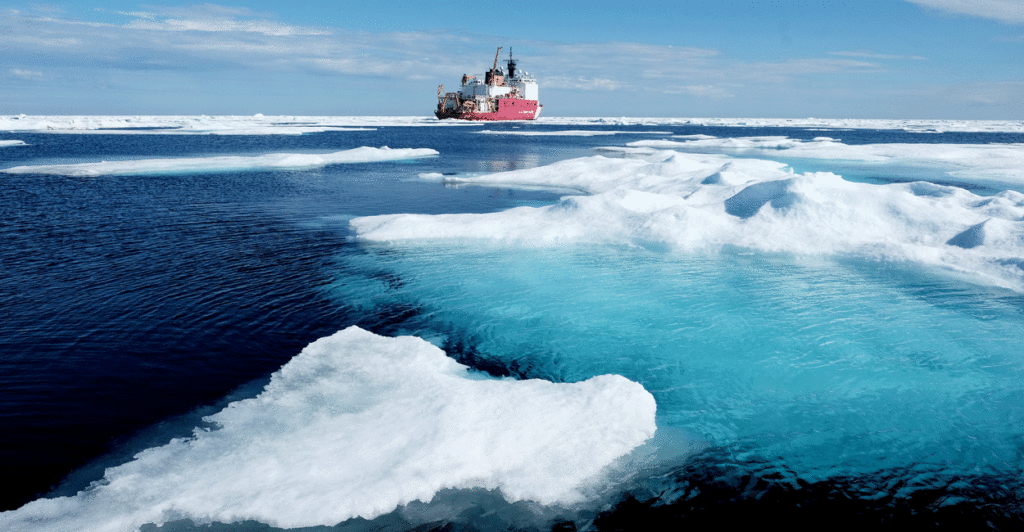President Joe Biden recognized the U.S. Coast Guard’s crucial presence in the Arctic Ocean during his address to the U.S. Coast Guard Academy’s graduating cadets in New London, Connecticut, on May 19.
But it will take more than words to compete against China and Russia in the Arctic Circle.
The U.S. has been an Arctic nation—meaning it possesses resources and territory above the Arctic Circle—since it purchased Alaska in 1867. It also supports research and upholds treaties in Antarctica.
The Arctic Circle has rare earth minerals and untapped oil and gas. As of June 2020, about 13% of oil resources and 30% of gas resources are undiscovered in the region.
Icebreaker ships will help the U.S. remain competitive with Russia and China. The Coast Guard uses them to access strategic and economic interests in the Arctic region. These ships are the most efficient and effective tool for conducting research and maintaining access in the icy waters where these are valuable U.S. resources.
But the federal government has not invested in new icebreaker ships since the Healy was commissioned in 1999. The U.S. does not have any working icebreakers in U.S.-claimed Arctic waters north of Alaska.
The Coast Guard’s icebreaking fleet has a total of two ships: the Polar Star and the Healy.
The Polar Star, commissioned more than four decades ago, has passed its 30-year life expectancy. It makes only one annual trip to Antarctica to resupply the McMurdo Station.
The Healy suffered an electrical fire while on a mission in the Arctic in August 2020 and will not resume service until August 2021.
In other words: One ship has surpassed its intended lifespan, while the other has been incapacitated for one year.
Meanwhile, Russia has the largest icebreaking fleet in the world, numbering over 40 total, with three more under construction and a dozen planned in the next decade. Because the U.S. does not have any icebreakers patrolling the Arctic, it must rely on other countries—including Russia—to fulfill its icebreaking needs.
With increasing activity and competition in the region over trade and resources, this is an unfavorable position to be in.
China, a self-described “near-Arctic state” that does not own any actual territory in the Arctic, operates two working icebreakers and is working to build its first nuclear-powered icebreaker. After Russia, China will be the second country to operate nuclear icebreakers, which are much more powerful than diesel-powered ships.
The real possibility of Russian or Chinese expansion into the United States’ rightful share of Arctic resources should alarm the Biden administration, to say the least.
The Heritage Foundation has called for the U.S. to expand its fleet—quickly—to secure American strategic interests.
>>> The Daily Signal is the news and commentary platform of The Heritage Foundation.
The Trump administration placed more funds into the Polar Security Cutter program that outlines a plan to construct six new icebreakers, with the first scheduled to begin sea trials by 2024. Three of these ships—heavy polar icebreakers—have the capacity to cut through ice that is at least 10-feet thick. The other three—medium icebreakers—can crack through about 8 feet of ice.
The icebreakers currently operated by the Coast Guard, known as Polar Security Cutters, do all the same things other Coast Guard cutters do, including search and rescue, law enforcement, and national security missions. Spanning at least 65 feet in length, crews can live on these cutters that patrol areas like the Caribbean where migrant and drug trafficking issues are prevalent.
Unlike regular cutters, Polar Security Cutters can also break through thick ice. This means they can operate in areas that would otherwise not have a U.S. presence, aside from aircraft and submarines.
The Biden administration’s new Coast Guard’s budget requests $170 million for the Polar Security Cutter program to construct the first two cutters and requests long-lead materials for the third. Long-lead materials are components that take the longest to obtain for a ship’s construction.
The Biden administration’s budget request prioritizes Polar Security Cutters. This budget allocates $1 billion toward investing in vessels, with about 17% funding Polar Security Cutters alone.
In the meantime, the Coast Guard must operate its current assets, which is why $15 million of this budget will go toward sustaining the aged Polar Star. The sooner the Coast Guard commissions new ships, the sooner it can halt funding for repairing aging cutters.
Even after the initial acquisition of the three heavy icebreakers, the Coast Guard really needs all six to meet the growing demands from China and Russia in the Arctic region.
Supplying the Coast Guard with a larger icebreaking fleet will allow it to fulfill its mission motto—“semper paratus,” Latin for “always ready”—and confront any challenge that comes its way.
Have an opinion about this article? To sound off, please email letters@DailySignal.com and we’ll consider publishing your edited remarks in our regular “We Hear You” feature. Remember to include the URL or headline of the article plus your name and town and/or state.
